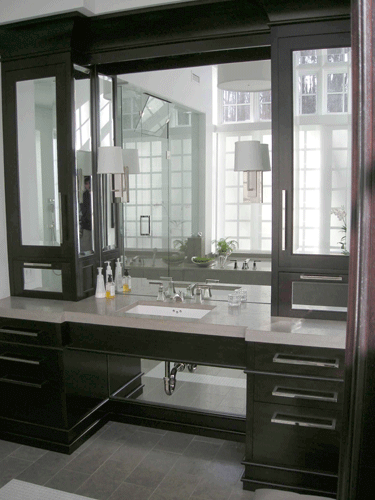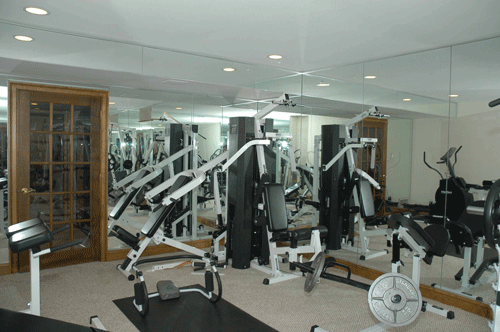Mirror Care
Preparation
Substrate walls of block, sheetrock or wood should be painted or sealed prior to installation to prevent leaching of harmful chemicals or moisture from attacking the back of the mirror. This also helps to prevent the substrate from absorbing moisture out of the mirror adhesive which may cause it to fail. Walls should be as flat as possible to prevent excessive distortion.
Installation
Our number one concern is to install all mirrors in a safe  manner. We strongly recommend that every mirror be mounted to the wall mechanically with J-channel, clips, or a combination thereof. Mirrors that are mounted mechanically are more secure than mirrors that are only taped or glued. In fact, the instructions for most types of mastic glue or mounting tape recommend that they be used in conjunction with some form of mechanical fastening. Mirrors installed only with tape or glue can fall down without warning. In a hazardous area such as a jacuzzi, we use a combination of both mechanical fastening and safety backing or mastic to provide two types of fastening for extra protection. In addition to the safety factor, our installation techniques provide a number of other benefits:
manner. We strongly recommend that every mirror be mounted to the wall mechanically with J-channel, clips, or a combination thereof. Mirrors that are mounted mechanically are more secure than mirrors that are only taped or glued. In fact, the instructions for most types of mastic glue or mounting tape recommend that they be used in conjunction with some form of mechanical fastening. Mirrors installed only with tape or glue can fall down without warning. In a hazardous area such as a jacuzzi, we use a combination of both mechanical fastening and safety backing or mastic to provide two types of fastening for extra protection. In addition to the safety factor, our installation techniques provide a number of other benefits:
Mechanical fastening eliminates the possibility of attack on the mirror backing by mastic glue or mounting tape. The National Association of Mirror Manufacturers recommends that mastic or tape not be used if other methods are possible because, "Many mastics attack the mirror backing. Also, the installation is not as secure as with other mounting methods."
Mirrors are mounted approximately 1/8" from the wall to reduce possible stress and abrasion to the mirror because of walls that are not plumb. It also allows for ventilation which helps prevent damage from water condensation that could otherwise collect on the back of the mirror.
The bottom edge of the mirrors are set on neoprene setting blocks. This provides proper support for the mirror, and allows for ventilation which helps prevent damage from water or cleaning solution that could otherwise collect on the bottom of the mirror. Mirrors should not be mounted directly on the back splash or baseboard.
We seal the edges of our mirrors with mirror edge sealant to help reduce exposure of the mirror's silver backing at the edges of the mirror. Sealing helps prevent black edge and protects the mirror when it is being handled, transported, installed and cleaned.
 Quality
Quality
Your new mirror may contain what the National Association of Mirror Manufacturers terms as "acceptable defects". The Association defines acceptable defects as those defects which are not visible to the naked eye under normal viewing conditions. Normal viewing conditions are defined as regular fixed lighting with a viewing distance of three feet or more with a viewing angle of 30 to 90 degrees. Common acceptable defects are light hairline scratches, pin head bubbles and light rubs.
Cleaning and Care
Your safest cleaner for your mirrors is warm water and a soft, clean, lint-free cloth or paper towel. Apply the cleaner to the cloth and wipe the mirror. Make sure to dry the mirror thoroughly, especially any exposed edges and joints that may get wet.
DO NOT - use any acid or alkali "clean up" solutions or other cleaners that contain abrasives, acids, alkali, ammonia, vinegar or chlorine; do not use dirty or gritty rags, powdered cleanser, steel wool or any other type of abrasive; DO NOT - spray directly on the mirror, especially near the edges. Most mirror failures are at the edges where "spillover" solutions attack the mirror backing at its most vulnerable point.
"A dry mirror is a happy mirror" Keep your house well ventilated and avoid splashing water on the mirrors. These simple suggestions will help you keep your mirrors bright and beautiful for many years.

